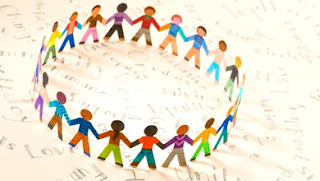 |
| Photo Credit: Forbes.com |
The traditional/popular discourse around diversity falls to pure demographics, focusing on the existence of different types of people. We typically see this in locations being described as racially diverse based on the proportions of various racial groups within the population. For example, a 2012 Huffington Post article provided results from a study by Brown University, identifying the U.S.’s most and least diverse cities. For this ranking, cities were scored “by how evenly each city’s population is spread across the five racial groups: Non-Hispanic whites, Hispanics of any race, African-Americans, Asians and an “other” category comprised of Native Americans, Alaska Natives and people of two or more races.”
Taking the stance that an integration of various groups makes an area “more diverse” than an area with existing, but segregated groups, it then seems pragmatic for those in community organizing to consider how integration occurs. During the class discussion which prompted my interest in this topic, one person noted the immense social separation that can exist between the ethnic areas of a city—and I was again brought back to my personal experience, and the social integration I have witnessed in D.C.’s Chinatown. So what makes Chinatown in D.C. succeed in integrating people across racial, ethnic, and economic lines, where other Chinatown’s stand isolated? The answer seems to lie in the economic and cultural infrastructure that has been infused into the neighborhood. As part of the introduction to a panel discussion exploring the impact Chinatown has had on D.C., the Urban Land Institute noted:
Fifteen years ago, Chinatown was a completely different place. It wasn’t
until the DC government approved its first ever tax-increment finance district
in 1999 that development and revitalization came to this neighborhood. And boy,
did it come.
 |
| Chinese New Year Parade, Chinatown, Washington, D.C. Photo Credit: Brian Lempin |
Even after
exploring how integration can further the diversity of a community, as well as
one mechanism for enhancing the level of integration, I am still left wondering
about the definition of diversity—knowing what makes “diversity” really count. For example, is the existence of different
groups, even if they are clearly segregated, better than a completely
homogeneous community? On one side you could argue that the mere existence
requires people to at least consider that there are other types of people. On the other side, you could argue that the
segregation may foster misconceptions that are not corrected without
interaction, and there is potential for the perpetuation of stereotypes. Now looking at the other end of what I am
dubbing “the diversity spectrum,” does too much integration lead to
assimilation or acculturation, potentially enabling the loss of what makes
groups different? There is a lot that
could be said about these questions, but I will leave that to another post.
In addition to the resources included
within the post, readers who enjoyed this discussion may be interested in the
following:
- San Diego's Population: Diversity and Interactions: This article provides an example of what it looks like to use diversity indices. The authors refer to both an isolation index, which indicates the likelihood that people of one race will meet others of the same race within their neighborhood, and an interaction index, which indicates the likelihood of meeting someone of another race within their neighborhood.
- Ethnic Integration Leads to Community Development: The organization Partners for Demographic Change provide a case from Bulgaria that exemplified the position that the mere existence of other groups does not equate to diversity if there is segregation and stereotypes, while also providing information on the organizations reaction to the segregation.
- Defining Diversity: Creating Community: Directed by Tony Papa, this film explores diversity and its meaning in the context of Powell River, a community in British Columbia, Canada. The story pulls from community members own narratives and seeks to explore how different people have come to Powell River and what their experiences of integration have been.
No comments:
Post a Comment